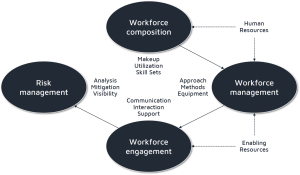5
For many non-profits, Covid-19 fundamentally impacts the workforce.[1] The pandemic’s nature and the associated complexities cause changes in requirements, retention and utilization decisions, and modifications to how people work. Organizations also face the potential of increased exposure to liability from “worst case” scenarios.
These challenges affect non-profits in several ways, as shown in Figure 7 (below). How they react will, to a significant extent, determine the success or failure of their strategic responses to the crisis. The workforce, after all, is a key factor in resource supply (see Section 3), and is key to the ability to meet shifting demand.
Figure 7 depicts the key areas in which the workforce is impacted, and non-profits can deal with them in two ways. They can react, addressing issues as they arise, or they can plan ahead.[2] Organizations that do the latter are more likely to get through the pandemic and serve clients cost-effectively, both short- and long-term.
Figure 7—Effects of Covid-19 on the Workforce

- Workforce composition is the number of people, mix of staff and volunteers, resource deployment, and skill sets. Requirements are affected by demand for services, program re-prioritization, new delivery methods, and infrastructure needs. Availability is impacted by financial conditions, resident skills, etc.
- Workforce management includes addressing both current guidelines[3] and changes due to a modified work environment, e.g., directing and managing staff,[4] facilitating team collaboration, providing enabling tools (technology and technical support, etc.), and ensuring information security.
- Workforce engagement is defined by changing Interactions, motivations, and stressors, which may be complicated by layoffs.[5] Variables that can impact engagement include mission connection, access to information, staff recognition, sense of community, and physical and emotional well-being.
- Risk management also needs to be considered in workforce adaptation due to the threat of exposure, impacts on image, and potential legal implications. This includes ensuring personal safety, being prepared in the event of a crisis,[6] and protecting the organization from exposure to liability.

Figure 8—Example Considerations for Workforce Adaptation
| Component | Conditions | Possible Responses |
| Workforce Composition |
Financial constraints |
|
| Program re-prioritization |
|
|
| Workforce Management |
Managing remote staff |
|
| Coordinating services |
|
|
| Workforce Engagement |
Motivating employees |
|
| Workforce stress |
|
|
| Workforce Risk Management |
“High-touch” requirements |
|
| Exposures to Covid-19 |
|
The Covid-19 pandemic changes the ways non-profits operate. Proactively and smartly adapting the workforce to these new conditions is essential. Smart staffing decisions and good workforce management, engagement, and risk practices will go a long way to determining which non-profits can successfully navigate this crisis.

Go to Session 3 presentation and recordings for a more detailed discussion
- Our definition of the workforce includes both staff and volunteers, the latter of which should in many ways be approached in the same way as employees with respect to regulations and management. ↵
- This means anticipating workforce conditions and challenges, and proactively developing responsive solutions in critical areas (see discussion below) through informed, strategic decisioning, updated policies and procedures for a new environment, etc. ↵
- E.g., Adherence to guidance local and state health departments and, for example, the Centers for Disease Control and Prevention (CDC), Food and Drug Administration (FDA), etc., and ensuring workplace safety and cleanliness, providing Personal Protective Equipment (PPE) requirements, updating leave guidelines, providing virus testing, managing potential and actual cases in the workplace, addressing Americans with Disabilities Act (ADA) and Occupational Safety and Health Administration (OSHA) issues, adjusting benefits (including but not limited to Workers Compensation, and dealing with employees who are reluctant to return to the physical work site. ↵
- Virtual workplaces, for example, require a shift from the concept of “supervision” to one of true “management,” driven by monitoring outputs rather than activities. This is new for many non-profits. ↵
- Assuming a non-profit wants and needs these employees and/or volunteers back when conditions permit, it is equally important to keep the displaced workforce engaged, and the same variables apply. ↵
- This is further discussed, along with the possible external impacts of exposure, in Section 7 (Contingency Planning). ↵
- Layoffs should be viewed as a last resort, but may be necessary. If they are, many non-profits will need to scale back services, as over-burdening remaining staff is an unsustainable practice. ↵
- In case re-training is infeasible given the skills required and/or time sensitivity. This can be difficult as it may involve letting some staff members go and hiring new people, which at the least can affect image and workforce morale, and may also have longer-term impacts. ↵
- For example, Employee Assistance Programs (EAPs). ↵
- Including but not limited to medical, HR, legal, and Public Relations (PR) or Crisis Communications support (see Section 7 for more). ↵
